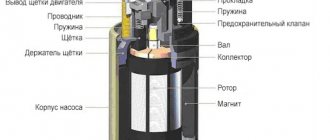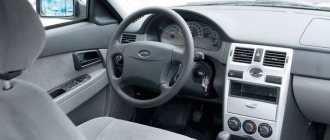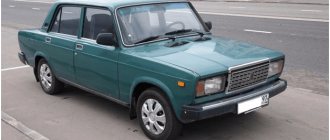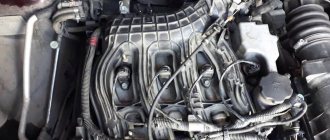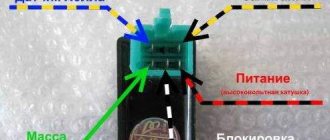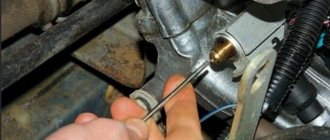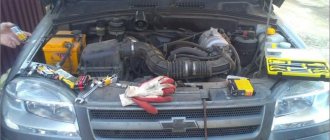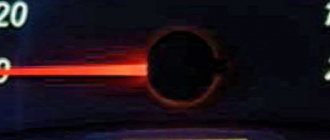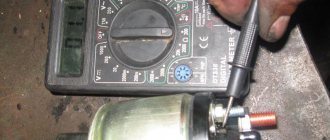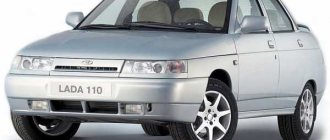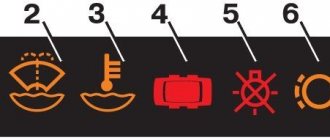Fuel module
The task of the fuel module is to supply gasoline at the required pressure to the fuel rail. The unit consists of a fuel pump, a fuel level sensor in the tank, and a filter mesh. The pressure in the system can be influenced by both the degree of clogging of the coarse filter and the performance of the pump.
Normal pressure in the Sens fuel system is from 3 to 3.5 atm . In this case, it is necessary to take into account the degree of wear of the pump itself and the primary filter. For example, depending on the condition of the pump, the pressure may drop to a critical 2 atmospheres . A clogged filter mesh can also lead to such consequences.
With such pressure in the system, the engine is physically unable to start.
To check the condition of the fuel pump, you need to insert the key into the ignition switch and turn it to the ignition on position. At this moment, the fuel pump should start and pump fuel into the ramp. If the filter is clean and there are no problems with the pump.
What fuel pressure in the rail should be
Normal pressure is considered to be 2.5 atmospheres at idle. When gas is added, the pressure briefly increases to 3-3.2 atmospheres - this is a kind of imitation of an accelerator pump, like on a carburetor. These indicators are influenced by several factors:
- rail pressure regulator;
- fuel pump performance.
If the fuel pump does not provide the proper pressure, then there will be no pressure in the ramp. But within certain limits, the ECU will be able to compensate for this by increasing the injection time. But at low pressure, the accelerator pump imitation will not work, which will lead to failures.
A working fuel pump gives a pressure of about 5-7 atmospheres. But then how does 2.5-3 stay on the ramp? It's simple - the pressure regulator in the fuel rail is responsible for this. This is a small bypass valve, which is located on the rack, in the area of the fourth cylinder. Structurally, the pressure regulator is made in the form of a spring-loaded valve, which is also connected to a vacuum membrane.
You've probably seen that the rail pressure regulator is connected by a thin tube to the intake manifold. If it is disconnected from the manifold, it will maintain pressure due to the spring, and it will be equal to 3-3.2 atmospheres. And when the vacuum tube is connected, not only the spring, but also the membrane acts on the valve stem. Thus, the regulator has the ability to further adjust the fuel pressure in the rail due to changes in the vacuum in the manifold.
The main reasons for lack of charging
Electrical system problems are often difficult to diagnose because they can be caused by either the alternator or a faulty battery. To understand the differences, you need to know the reasons why the generator may not provide a charge. Then you need to carry out diagnostics, which will allow you to determine whether the problem really lies in the generator.
Below are the 5 most common reasons why your alternator may not be charging your battery.
- Error in the control unit. Most of the cars in use were produced no more than 20 years ago, and many models are controlled by a computer system that also controls the generator. If an error occurs in the corresponding control unit, the operation of the generator may be impaired. At the same time, it will stop charging the battery.
- Damage to the drive belt and pulley. The belt and pulley are elements that are sources of mechanical energy, which is then converted into electrical energy. The belt breaks easily due to stretching, and the pulley can be damaged during operation. In both cases, the generator will not be able to generate electrical energy.
- Blown fuse. In some cases, a separate fuse may be provided for the generator. Over time or as a result of a short circuit, it may burn out, after which the generator will become inoperable. However, not all vehicles have this type of fuse, so you must consult your owner's manual to determine if your vehicle has one. If yes, then you need to check its condition - there is a possibility that its failure is the reason for the inoperability of the generator.
- Wire fault. The electricity generated by the generator is supplied to consumers through a network of wires. It is enough to damage or disconnect one of them, and the generator will stop charging the battery.
- Alternator or battery malfunction. Generators and batteries do not last forever; their resource is limited. The battery life is 2–5 years, depending on operating conditions. Batteries last longer in cold climates and less in hot climates.
Re: ZAZ Sens won't start when cold.
Message from
Sergey reg16Open the control unit and check for water. gasoline enters the intake manifold through the membrane. Coolant level, how about compression? throw in another control unit that is known to be good. The crankshaft sensor also often suffers from water; it flows through the wire under the plastic of the housing. And finally, fill in another gasoline.
The block is dry, the surrounding area is also dry, the RTD is new (it was changed a month ago), the level does not go anywhere, the compression is 12/11.8/12/12 +-0.1, there is no known good ECU and nowhere to get it, the DPCV does not look bad (how to check it? ), fresh gasoline did not help.
Vadim UA
, the temperature differs by 2 degrees...
Elimination methods
Now that the causes and possible systems where the problem will be hidden have been found, it will be necessary to conduct computer diagnostics and find the malfunction. This will require tools, as well as knowledge of the design features of Daewoo Lanos.
It is worth immediately warning that if the owner does not know how his car works, it is recommended to contact a car service center. So, let's consider the sequence of operations that will be aimed at correcting the problem, as well as returning the power unit to its previous strength.
Reasons why Chevrolet Lanos does not start
Why won't the engine start?
To identify problems and causes, you first need to understand what works and what doesn't . So, turn the ignition key and try to turn the crankshaft. If we are talking about this particular problem, then the starter will turn, but the air-fuel mixture will not ignite.
The cause of this malfunction must be sought in the following systems:
- Fuel line and its elements.
- Ignition system.
- Air supply system.
- Electronics.
Elimination methods and diagnostics
Now that the causes and possible systems where the problem will lie have been found, it is necessary to carry out diagnostic operations and find solutions.
This will require tools, as well as knowledge of the design of the Chevrolet Lanos.
It’s worth warning right away that if there is a car enthusiast who doesn’t know how his car works, then he has a direct route to a car service center. So, let's consider the sequence of actions that will be aimed at correcting the problem and returning the power unit to its previous qualities.
Gasoline pump
Dirty fuel pump. Dismantling process for diagnostics and restoration.
It’s worth starting by checking the functionality of the gasoline pump.
So, to do this, you need to turn the ignition key to the first position and listen to see if there is a characteristic operating noise of the unit. If there is none, then there is probably no fuel supply to the combustion chambers, and it is worth checking the part.
Fuse and relay box under the hood
It is located near the battery and is closed with a protective cover, which is held on by two side latches.
Block diagram
Description of fuses and relays Chevrolet Lanos
Circuit breakers
| EF1 | 80A Fuse circuits EF15 - EF20 and F1 - F7 |
| EF2 | 30A Ignition switch (power supply circuit for instrument cluster and fuel pump) |
| EF3 | 30A Ignition switch (starter, heater fan, power windows) |
| EF4 | 30A Electric motors of the main and additional fans |
| EF5 | 30A Electric window motors |
| EF6 | 50A Not used |
| EF7 | 30A Rear window heating element |
| EF8 | 30A Heater fan motor (4th speed) |
| D9 (diode) | Air conditioning compressor electromagnetic clutch |
| EF10 | 20A Headlight bulbs (high beam) |
| EF11 | 10A Lamp for the left headlight (low beam), motor-reducer for adjusting the direction of the light beam of the left headlight |
| EF12 | 10A Lamp for the right headlight (low beam), motor-reducer for adjusting the direction of the light beam of the right headlight |
| EF13 | 10A Brake signal/side light lamp in the left rear light (side light), instrument cluster illumination, melodic signal, side light lamp in the left headlight, headlight beam adjustment switch, fog light switch in the rear light, clock, switch hazard warning lights, ashtray lights, audio system, chevrolet lanos air conditioning switch |
| EF14 | 10A Brake/side light lamp in the right rear light (side light), side light lamp in the right headlight, license plate lights |
| EF15 | 15A Chevrolet Lanos fog lamps |
| EF16 | 15AT fuel pump |
| EF17 | 10A Horn |
| EF18 | 10A Electromagnetic clutch of the air conditioning compressor |
| EF19 | 25A Contact “30” headlight relay |
| EF20 | 20A Contact “30” side light and interior lighting relay |
Relay
| Name | |
| K1 | Sound signal |
| K2 | Headlight bulbs |
| short circuit | Air conditioning compressor electromagnetic clutch |
| K4 | Additional cooling fan motor |
| K5 | Fog lamps |
| K6 | Side light lamps in the headlights, brake signal/side light lamps in the rear lights (side light), instrument cluster illumination lamps, interior courtesy lamp |
| K7 | Power window motors |
| K8 | Main cooling fan motor |
| K9 | Fuel pump motor |
| K10 | Rear window heating element |
| K11 | Relay for the electric motors of the main and additional cooling system fans |
Checking the fuel pump relay
The fuel pump activation relay is located in the relay box located in the right rear of the engine compartment. It is used to control the operation of the electric fuel pump.
In particular, the relay breaks the pump power circuit if the engine stops with the ignition on. To turn on the fuel pump when the engine is stopped, you need to remove the relay and close contacts 30 and 87 on the connector with a short wire with a diameter of 1.5 mm. The fuel pump relay is brown on the 520i/525i/524td and orange on the 530i/535i.
Attention: when checking the fuel pump activation relay, the battery must be charged.
• Check fuse No. 23.
• Connect a voltmeter to pins 30 (*) and 85 (-) on the relay connector. The voltage should be around 12V.
• If this is not the case. connect a voltmeter to pin 30 and ground. If the voltage is about 12 V, check the electrical diagram to see if the brown-green wire is broken. If it is intact, check the red wire and replace if necessary.
• Turn on the ignition. Connect a voltmeter to pin 86 (+) and ground. The reading should be around 12V Otherwise, check the electrical diagram to see if the red/white wire is broken and replace it if necessary.
• Check the presence of a signal at the output of the crankshaft speed/angular position sensor (to do this, contact a service station).
• Connect a short jumper to pins 30 and 87. If the pump starts, replace the relay. Otherwise, check for an open and replace the green-violet wire if necessary.
• If the wire is OK, replace the fuel pump.
The well-known front-wheel drive Chevrolet Lanos, also known as Deo Lanos and ZAZ Chance, is equipped with a gasoline eight-valve engine with a displacement of 1.5 liters and a power of 86 hp. pp., is characterized by a reliable design and good controllability. Despite good technical characteristics, there are cases when, after turning on the ignition, the fuel pump does not make a characteristic sound, that is, it does not work or, on the contrary, constantly hums. These signs are a reason to check the serviceability of the Chevrolet Lanos fuel pump relay.
Reviving a “dead man” - is he dead?
The first sign of trouble that I noticed was the fuel pump not working. It was him who I rushed to revive first, which turned out to be not quite the right decision. If your car (or any other equipment) breaks down, carefully examine the problem from all sides: maybe there are some other signs of breakdown , because the car is a rather complex system of units (which, by the way, has its own built-in diagnostics). If I had directly connected the wire from the battery to the fuel pump connector (that is, supplied it with 12 volts, eliminating all intermediaries in the electrical circuit), I would definitely have been convinced that the pump is alive. But... the engine still wouldn’t start! Then, I would check to see if there was a spark at the spark plugs, and I would be very sad because there was none. After reading the forums, you can be horrified at how much time and money some people with the same problem spent solving it, changing one car service center for another.
What can you do if the Chevrolet Lanos does not start?
If you don’t have time to repair your car at the moment, you should relax and do other things. Determining a malfunction is a long and painstaking task.
| The starter does not turn | If it does not spin, you need to check the electrical ignition circuit. |
| No battery charging | The entire electrical system is not working. You need to replace the old battery or try cleaning the terminals with fine-grit sandpaper. The battery may simply be discharged. The way out of this situation is to try to “light” it from another car |
| The starter turns, but the car does not start. | The battery is not to blame at all here. The problem may be with the fuel system or ignition. The 2nd option is most likely, since it is the ignition that breaks down more often than others. You need to remove the distributor cap and make sure that there is no moisture through which the spark gets to another place. Using a tester, check for damage to the coil. |
If these options do not help, then the car will have to be taken to a repair shop. The main reasons why the Chevrolet Lanos does not start are the violation of three components: air supply, fuel and the occurrence of a spark. Qualified specialists will certainly help in identifying the malfunction.
Breakdowns in a Chevrolet Lanos car
But a car, like other types of transport, can break down. Let's take a closer look at the breakdown of the fuel pump.
The moment we start the car, we always hear the sound of the fuel pump operating. Then it raises the pressure in the fuel rail, and the electrical unit turns it off. Then the fuel pump turns on automatically only when the engine rotates. When the crankshaft sensor begins to transmit pulses, voltage is applied to the coil, which is what helps supply voltage to the electric motor.
If you cannot hear the sound of a running fuel pump, then it is likely that the fuel pump in the Chevrolet Lanos is not working. In order to check yourself, you need to perform several steps.
- Raise the rear seat (passenger side).
- We see a hole in the flask, carefully remove it.
- Direct the hole with the contacts towards you.
- We connect a special tester to them. We start the car and check for voltage.
Chevrolet car repair manuals and tips
I've been wanting to replace the strainer in the fuel pump for a long time. Once I tried to open it (as I had a problem with the exhaust, there was an entry in the BZ) but it didn’t work. So the day came when I managed to open the pump and change the filter. The mesh cost 100 rubles.
Two hooks from the electrode are visible here
First, we open the top cover of the flask; it doesn’t give much of a view, but we try to open nothing. We insert one hook into the inside of the flask, we hook this hook to something, and slowly pull with force, as soon as it moves a little we change the position, when we walk around in a circle, the inner part rises a little; a second hook will be needed in order to reach the inner part of the flask without distortions. You also need to disconnect the wire connector, otherwise it won’t allow you to disassemble it completely. And when everything works out, you can rejoice, since this is the most difficult stage when replacing the mesh in the fuel pump.
Old and new mesh
I also removed the pump motor itself from its housing.
Replacement
We started the article with unexpected malfunctions of electrical appliances. Once you have an idea of what the Chevrolet Lanos fuse box looks like and what its elements are responsible for, you can begin troubleshooting. The most common failure is the cigarette lighter, so let's look at the replacement process using it as an example.
First of all, you need to make sure that the cigarette lighter is really not working. There may be several reasons why it stopped performing its direct duties or charging your gadgets:
- blown fuse;
- clogged contact;
- inconsistent charger contact due to its configuration;
- problems with wiring or contacts.
The last case is very rare and least likely. We make sure that the nest is not filled with debris, dust, ash or tobacco. If so, clean the nest. Then check if your gadget's charger fits well into the socket. Perhaps this will be the problem and will be solved by purchasing a new charger. So, if all of the above problems do not affect you, then you need to replace the fuse. It is located in the indoor unit (read above for how to get to it) and is marked F10. Using tweezers, remove the old PP, make sure that it is really burnt (black, charred, melted) and insert a new one of the same rated current (15 A) in its place.
Also, Chevrolet Lanos car owners are faced with the fact that the car will not start. This problem can often be solved by replacing the fuel pump fuse. Watch the replacement video:
Ignition module
The ignition module's job is to supply voltage to the spark plugs. Over time, it may cease to perform its functions, which affects both engine starting and its operation in general.
First of all, you need to check for the presence of a spark. To do this, you need to unscrew any spark plug and place it on the ground of the car. When the engine is cranked by the starter, a spark should jump between the spark plug electrodes.
If there is no spark, you need to check the module connector. In addition, you need to check the fifth fuse from the right, its rating is 15 Amps .
There may be a problem with the contacts in the module itself. The wires in the module are made of aluminum and are not always properly soldered. Therefore, the problem with starting the engine may be intermittent. Theoretically, you can disassemble the module and solder the contacts, but this will not guarantee the functionality of the module.
Malfunction of the ignition module (coil) on Lanos and Chance: can the engine not start?
On injection cars, an ignition module is installed, which is designed to generate high-voltage voltage (this is the same coil, only consisting of semiconductor elements). To check this module you will need to use a multimeter that measures resistance. However, it is worth noting that such a device rarely fails, but the most important thing is that if it malfunctions, “Check” will light up on the dashboard. However, the indication does not say anything, since when the ignition is turned on, the “Check Engine” will light up in any case.
If there is a suspicion that the ignition module is faulty, then you should pay attention to a number of relevant signs. Typical symptoms of a faulty ignition module are: lack of spark on one of the spark plugs, floating speed, difficult starting in cold weather, power failures. Such a breakdown can be determined using computer diagnostics by looking at the oscillogram.
If, when starting the engine, the oscillogram shows no spark, then the reason is a faulty module. It is important to note that before drawing the appropriate conclusion, you should make sure that the spark plugs and armored wires are in good condition.
If there is a suspicion that the ignition module is faulty, then the first thing you should do is check the wires supplying this device. To do this, we use a continuity test and check the serviceability of the positive and negative wires in the connector.
If the supply wires are not working properly, then, most likely, the reason that the motor does not start is in them. There is no need to go far, and you should disassemble the insulation near the chip to make sure that the wires are not damaged.
The video below shows this problem and how to fix it.
If the supply wires are in good condition, then we check the serviceability of the contact groups on the block...
And in the ignition module connector.
If you or the technicians recently disconnected the connector, then incorrect connection could be the reason why the engine does not start. It is necessary to align the contacts and connect the block to the connector. If after this the engine does not start, then the module should be replaced. It is recommended to choose only original spare parts.
After replacing the module, we test run the engine. You can fix such a breakdown yourself, but do not rush to order an ignition module until you make sure that the spark plugs, armor wires and the presence of power at the terminal are in good condition. Below in the video you can see how troubleshooting specialists work on Lanos cars.
